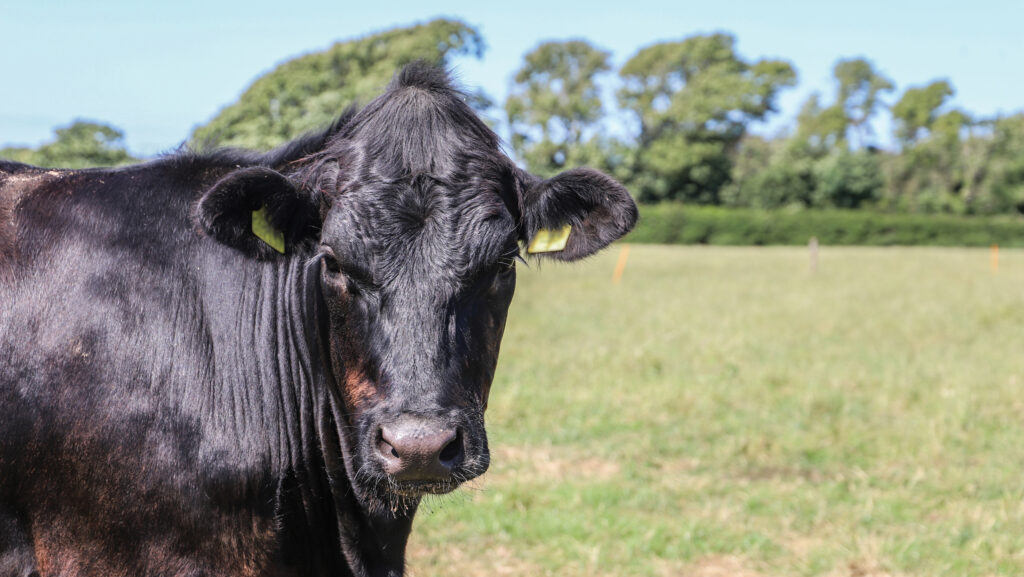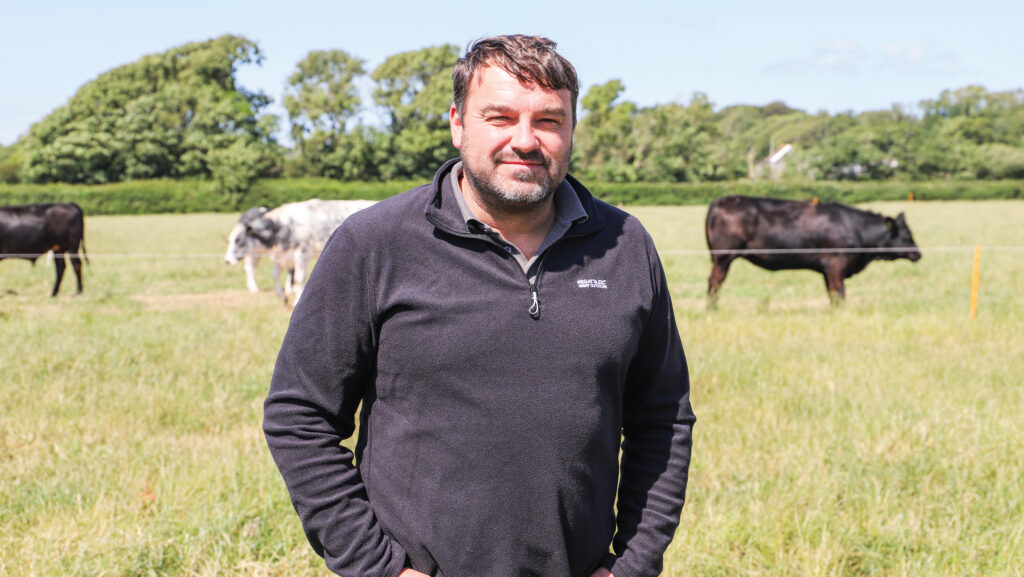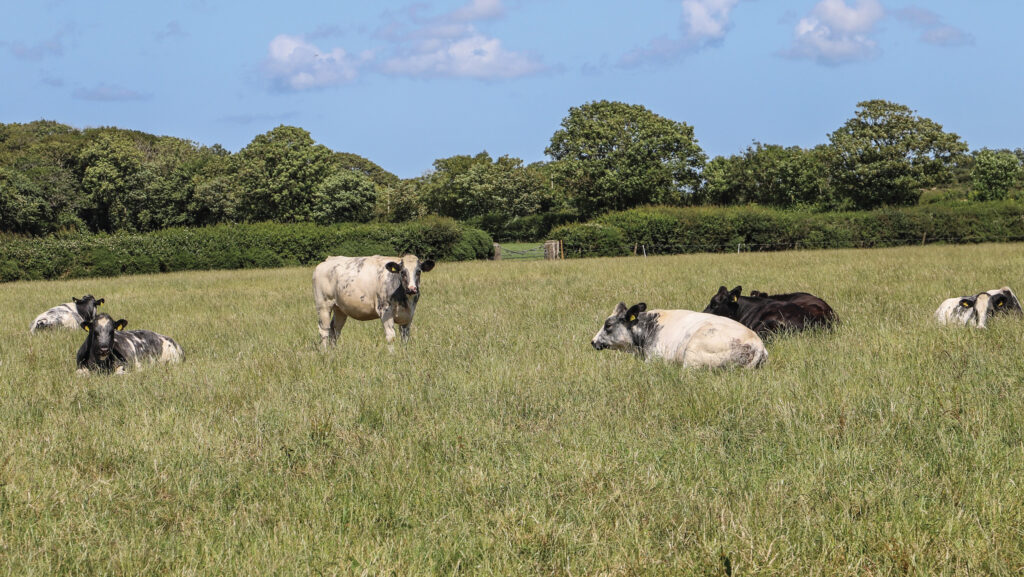Stores or finishers: Why doing the sums regularly is vital
 © Farming Connect
© Farming Connect Analysis of one business on Anglesey, carried out by Farming Connect, showed a net margin of £19/head of cattle finished, or £0.03/kg of liveweight sold.
This compares favourably with the latest Farm Business Wales Survey figures, which show that, on average, beef finishers who buy young and forward-store cattle or finish home-bred calves are making a loss of £0.31/kg.
See also: 7 focus areas for efficient beef finishing rations
The Farming Connect review focused on the Jones family, who run about 300 Angus-cross, British Blue and Hereford-cross cattle at Graianfryn, Llanfachraeth, which is part of the Farming Connect Our Farms network.
Gerallt Jones, who farms with his wife Hâf and his parents Alun and Rhiannon, sought help to inform decision-making about the future direction of the business.
The Joneses source calves year-round from local dairy farms as two- to three-week-olds.
Calves are fed milk replacer, concentrates and straw pre-weaning before being moved onto a total mixed ration (TMR) or turned out to graze, with concentrates fed until they are six months old.
At approximately 400-450kg, depending on the time of year, they are transitioned to a finishing diet of either grass and ad-lib barley mix, or a TMR of silage and concentrates for up to three months.
Optimum system
In 2023, 107 cattle were finished at an average liveweight of 600kg and sold to Woodheads or Kepak, but Gerallt questioned if supplying the store market could be more profitable.
He worked with Trystan Sion and Gareth Griffiths, of Mabis Amaeth, to review the operation.
They carried out a detailed analysis of the three-month finishing period and compared it with what could be achieved if the cattle were sold as stores at lighter weights.
Variable costs associated with the beef enterprise totalled £116,158 in 2023, with cattle feed, at £84,748, accounting for the most significant of these, as well as purchased concentrates including milk replacer.
Home-grown barley from the farm’s arable enterprise was also accounted for in the feed costs. Meanwhile, fixed costs totalled £41,002.

Gerallt Jones © Farming Connect
At a total cost of production of £157,160, the beef enterprise achieved a net margin of £2,009 in 2023.
This equates to £19 for each finished animal, and £0.03/kg of liveweight sold.
Trystan points out that the figures were taken during a year of transition, and the business is in the process of expanding cattle numbers.
Increasing the scale of the enterprise will dilute the overheads associated with the dairy beef enterprise, he predicts, adding: “It should increase net profit margins if gross margin figures remain as they are.”
Farm facts: Graianfryn, Anglesey
- 119ha of owned land and 2ha rented
- Owned land split into three blocks
- Low-lying land and medium soils
- Majority of land is grassland
- 20ha spring barley grown annually
- 500 indoor lambing north of England Mules
- All lambs finished off grass and sold liveweight and deadweight
Price checks
What the analysis shows is that the Joneses would not be better off selling the cattle earlier, as 450kg stores, even when compared against a housed-finishing system.
Using an estimated store price of £1,098 for a 450kg animal, Trystan calculates that the margin at Graianfryn would be £130.45 a head higher if the cattle were finished in a housed environment, and £195.90 a head in an outdoor system, compared with selling at store price.
The store value has been calculated on an average deadweight price of £1,464 at Graianfryn for a 600kg animal, giving an estimated liveweight price of £2.44/kg.
Trystan points out that the market price for stores, as well as deadweight prices, will have a big influence on whether cattle should be finished or not.
“A store price of £1,150, for example, would reduce the margin of indoor finishing to £78.45/head compared with selling as stores.
“On the other hand, a store price of £900 would leave a finishing margin of £328/head,” he says.
The calculations for Graianfryn only take into account variable costs specific to that business; these costs would be different for every farm.
The additional fixed costs associated with the finishing period such as labour, power, machinery and water, should also be considered, but these costs are likely to be much less significant than the variable costs.

© Farming Connect
Regular reviews
Trystan stresses the value in continually reviewing financial performance in beef enterprises.
“It is important to compare and evaluate if keeping the cattle through to finishing is a viable and worthwhile option, in comparison with selling them as stores,” he advises.
The enterprise review exercise at Graianfryn shows that the dairy beef finishing enterprise is marginally profitable after accounting for all costs, he adds.
“As the enterprise is only marginally profitable, an increase in feed costs or a decrease in the sale price of cattle, for example, could well lead to a loss rather than a profit.
“Therefore, continually monitoring the enterprise is essential to keep an eye on viability.”
For Gerallt, the exercise was a valuable one. Although he monitors his gross margins very closely and always has, factoring in the fixed costs and seeing the resulting net margins confirmed that he needed cattle numbers to make the financial side of the enterprise stack up.
“Most farmers will work out some form of gross margin but not look at the overall picture,” he says.
He will seek to reduce his costs to improve the net margin, but with costs right across the business already tightly controlled, he admits that it will be very difficult.
“We will look at producing more of our own feed, but after a terrible growing and harvesting season this year, that is easier said than done.
“We were only able to get the last of the barley crop harvested in the last week of September, and with conditions now turning very wet, it is looking likely that we might have difficulty in getting that land reseeded.
“We could, therefore, lose that acreage for producing the feed we rely on to get the early crop of lambs off in the spring.”
Beef finishing versus stores
- Assess the viability of the enterprise during the finishing period to calculate the daily liveweight gain needed to cover variable costs, particularly feed
- Weigh cattle regularly during finishing to check they are growing at a rate that covers their feed costs
- Keep an eye on store prices as well as deadweight prices to assess both options
- Analyse rations and home-grown forage costs to identify if feed costs can be reduced without compromising output to increase potential margins.
Source: Trystan Sion and Gareth Griffiths, Mabis Amaeth
